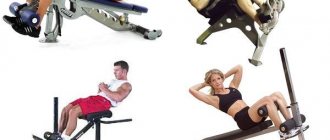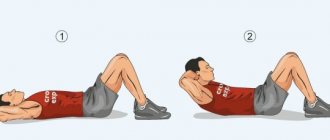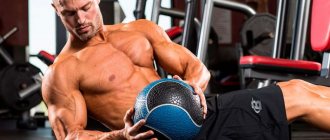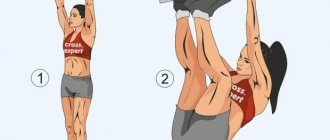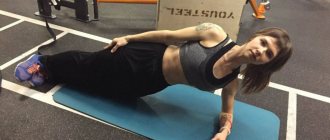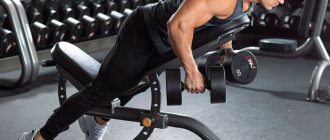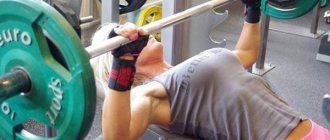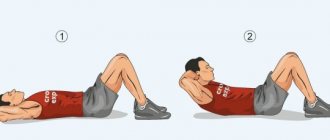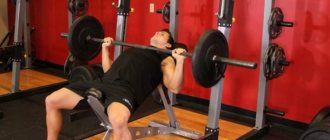A classic exercise for strengthening the abdominal muscles is crunches. And since the muscles quickly get used to the same load, the types of twists should be alternated. One way to vary your workout is to do incline crunches.
- What muscles is the exercise aimed at working?
- Roman bench for the press
- Incline crunches
- Technique for performing classic crunches
- Video: correctly pump up the crunch press on a Roman bench
- Technique for performing crunches with rotation
- Video: crunches with rotation on an incline bench
- Other incline abdominal exercises
- Technique for performing body raises on an inclined bench
- Technique for performing body raises on an inclined bench with rotation
- Video: Incline sit-ups with rotation
- Helpful Tips for Performing Incline Crunches
What muscles is the exercise aimed at working?
When performing crunches on an incline bench, the abdominal muscles are primarily involved in the work. With classic crunches, the rectus muscles bear the greatest load, but if we perform crunches with rotation, then the emphasis falls on the lateral zones - the serratus and oblique muscles. The work also involves the rectus femoris muscles, which maintain body position and balance.
An incline bench allows you to work all the abdominal muscles.
#1 Returning to the starting position too quickly
Negative and positive phases
As with all strength exercises, crunches have two phases of movement - positive and negative. In the first phase the muscle contracts, in the second it stretches.
Accordingly, in the positive phase your body approaches your hips, in the negative phase it returns to its original position.
So here it is. Both phases are equally important for your progress:
- The positive phase helps increase strength.
- The negative one has a more shock effect on the muscles and activates a larger number of fibers, therefore, it works to increase lean muscle mass.
Error
If you return to the starting position too quickly, you deprive yourself of all the bonuses that your muscles can receive and make your work easier.
Solution
Try to return to the starting position slowly without jerking. Your speed in the negative phase may even be less than in the positive phase.
Roman bench for the press
An inclined (Roman) abdominal bench is one of the simplest exercise machines that can be found in gyms, and can also be purchased for home use, since it is quite inexpensive.
The design of the simulator may vary as shown in the pictures:
- non-adjustable benches: the angle of inclination is fixed and does not change;
A non-adjustable incline bench involves only one level of incline, to which the abs quickly adapt.
- the bench is part of another exercise machine (for example, a wall bars) or requires additional equipment to secure and change the angle;
This type of bench is more suitable for use in fitness centers than at home due to its bulky size.
- adjustable benches: the angle of inclination varies (the adjustment design may vary from machine to machine).
An adjustable incline bench can have a wide range of incline angles from easier to very difficult.
You should not buy a bench online without checking first, as it may not suit you and may be uncomfortable.
When choosing a bench you should pay attention to:
- The quality and strength of the support frame. A low-grade design will very quickly begin to creak and wobble when performing the exercise.
- The material from which the back upholstery is made. It is better if it is hypoallergenic, since the area of contact with the skin is quite large, and non-slip. Also pay attention to the seams: under load, poorly processed seams will quickly begin to separate. Artificial leather has proven itself to be the most durable material.
- Rollers for securing the legs. They should be soft enough so that there are no bruises or unpleasant sensations during the exercise.
- The maximum user weight allowed for training on the machine.
Reverse crunches: what's the point?
Straight crunches mean that you lift your body off the floor while performing the exercise. In reverse crunches you will lift your pelvis and legs off the floor. When we pump our abs, we use the rectus abdominis muscle. “One of the functions of the rectus abdominis muscle is to pull the ribs towards the pubic bone or vice versa,” says Valentin Zinin , instructor of SuperPopa group programs at Kometa.fit clubs .
— In order to activate the rectus abdominis muscle, we can do classic crunches or reverse crunches. There is no significant difference in the results of these types of exercises.” Some experts say that reverse crunches help to better work the lower segment of the rectus muscle (those “lower abs”), but there is no direct evidence of this. If you eat right, exercise regularly and do abdominal exercises (even straight crunches), then most likely your “lower abs” will be clearly visible.
Incline crunches
Now let's move on directly to the exercises that can be performed on an incline bench. Crunches can be done in the classic way, in which you lift your body straight, or with a twist, when you lift your body to the side.
Please note that incline crunches are contraindicated for people suffering from hypertension, intracranial pressure or frequent migraines.
Technique for performing classic crunches
When performing crunches, it is important not to lift your lower back from the surface, only your shoulder blades.
- We sit on the bench, secure our legs under the bolster and lie down with our whole body - hips, lower back, shoulder blades and head lie on the bench.
- We put our hands behind our heads.
- We take a deep breath and, as we exhale, use the abdominal muscles to lift the upper part of the body. We tear off only the shoulder blades from the bench, the lower back is still pressed to the bench.
- Do not put pressure on your head with your hands; try to lift your body with your abdominal muscles. At the top point, exhale and tense your abs.
- We return to the starting position and relax the muscles.
We perform 3–4 approaches. The number of repetitions may vary depending on how long ago you started exercising: on average, from 8-12 times for a beginner to 15-20 times for an experienced athlete.
Video: correctly pump up the crunch press on a Roman bench
Video on how to properly pump up your abs when performing crunches on an incline bench:
Technique for performing crunches with rotation
- We sit on an inclined bench, fix our shins under the bolster and lie down.
- The shoulder blades, lower back, hips and head lie completely on the surface of the bench.
- Place your palms on the back of your head.
- Take a deep breath and, as you exhale, lift your upper body. The lower back should remain on the bench.
- In this case, the elbow of the right hand tends towards the left knee, and the left elbow - towards the right.
In this version of crunches, primarily the internal and external oblique and serratus abdominal muscles are loaded.
Number of repetitions: 15–20, 3–4 sets.
Video: crunches with rotation on an incline bench
Video of abdominal swing using crunches with rotation on an incline bench:
Benefits of crunches
This element is used in both women's and men's fitness programs. Its popularity is due to its beneficial properties:
- High-quality press work. There are many variations of crunches. If you correctly combine several similar exercises in a program, the abdominal muscles will receive a complex load, which will increase the effectiveness of the training.
- Improved spine flexibility. Twisting has a positive effect on the extensibility of the vertebrae, improves overall back mobility, and relieves pain associated with muscle strain.
- Universal application. Many exercise options do not require the purchase of additional sports equipment, so crunches can be done not only in the gym, but also at home.
- Figure correction. Twisting from different positions indirectly affects other muscle groups. For example, when performing an exercise with your back resting on a fitness ball, your hips and buttocks are additionally loaded, holding the pelvis suspended. Due to this, there is an increased consumption of calories and, as a result, weight loss.
Advice for newbies! There is no need to train your abs on a separate day. The abdominal muscles are involved in most exercises: deadlifts, presses, squats and others. Therefore, it is better to add 2 different variations of crunches at the end of each lesson. This way you will avoid overtraining your abs and give this muscle group a good workout.
The exercises in question can be used for various purposes:
- to work out the relief (example: high-speed crunches on the floor);
- to increase the strength of the abdominal muscles (example: crunches in a block machine).
Other incline abdominal exercises
In addition to the twisting options that we described below, other abdominal exercises are performed on an incline bench - this is a complete lifting of the torso, and not just the upper part.
This exercise also involves the classic version and lifting with a turn.
Technique for performing body raises on an inclined bench
A more common variation of the incline ab exercise is a full body raise.
- We sit on the bench and fix our legs with bolsters.
- Your arms can be placed behind your head, crossed over your chest, or extended along your body. At the same time, the difficulty of the exercise will change depending on the position of the hands. So, with outstretched arms it is easiest to lift, while with your hands behind your head it will be more difficult.
- Usually two options are performed: either get up from a lying position, or do not lie down on the bench completely.
- The first option assumes that at the lowest point you lie down with your whole body on the bench and relax your abs, after which you exhale and rise again; the exercise is shown in the photo below.
Technique for performing the exercise: lifting the body to the press from a lying position.
- The second option is somewhat more effective, since the abs do not relax at the lowest point, but are tense all the time. In addition, there is no strong swing amplitude, which can make some people feel dizzy.
Technique for performing the exercise: raising the body on an inclined bench in a small amplitude.
- Thus, as we inhale, we lower ourselves down, but do not touch the bench. We keep our stomach in good shape all the time.
- With an exhalation, we rise up, but also do not sit completely straight, so as not to relax the stomach. You need to move with a small amplitude.
- One of the most important rules when performing this exercise is to monitor the position of your back. Under no circumstances should you rise with a straight back; it should be rounded. This will remove the load from it and reduce the likelihood of injury.
Number of repetitions: 15–20 for 4 sets.
Technique for performing body raises on an inclined bench with rotation
To emphasize the lateral abdominal muscles, perform lifts with a rotation of the body.
- As in previous versions of the exercise, we sit on a bench and securely fix our legs under the bolsters.
- The back is round, it is most convenient to put your hands behind your head, but you can also stretch them along the body or cross them over your chest.
- As we inhale, we lower ourselves down. There are also two options - either we lie down completely on the bench, or we remain tense and do not touch the surface.
- As you exhale, we rise up, while twisting the body to the right. We exhale as much as possible, hold at the top point for a couple of seconds and lower down. Now we go up and turn left.
Number of repetitions: 15–20 for 4 sets.
Video: Incline sit-ups with rotation
Typical beginner mistakes
Many abdominal exercises have their own technical nuances that you need to master in order to get the most out of them. Let's look at the most common mistakes, myths and misconceptions:
- You should not train your abs more than 1-2 times a week. Crunches are a fairly easy exercise, but even after it the body needs time to recover.
- By performing a large number of repetitions, you will not burn excess fat deposits on your stomach and get the coveted “cubes”. The optimal repetition range for crunches is 12-20; in combination with a diet tailored to your goals, this approach will give maximum results.
- Do not use too heavy a weight. If you do crunches with a disc or dumbbell, do not chase the weights, it is better to focus on mental concentration and contract the abdominal muscles more isolated, but involving no assistant muscles in the work.
Recipes for healthy eating
Casserole with chicken and vegetables
- 11.5 g Protein
- 3.2 g Fat
- 5.6 g Carbohydrates
- 98.6 kcal
80 min.
- #dietary
- #breakfast
- #baking
- #zucchini
- #corn
- #chicken
- #pita
- #low calorie
- #dinner
- #parsley
- #onion
- #sour cream
- #spices
- #cheese
- #dinner
- #garlic
Other recipes
Helpful Tips for Performing Incline Crunches
To increase the effectiveness and reduce the risk of injury, it is worth considering a number of nuances.
- The exercise of sit-ups or crunches on an incline bench can be made more difficult by holding a weight in your hands. Usually they take a weight plate or a dumbbell. You can hold the weight behind your head or near your chest.
- For beginners, the bench angle should be 10–15 degrees. You should not do an inclination angle greater than 45 degrees, since blood will actively rush to the head, which can negatively affect your well-being.
- It is important to perform the exercise using the abdominal muscles. Many novice athletes with weak abs and undeveloped body awareness begin to actively help themselves with their legs, as well as with their arms, pulling their heads up. This takes some of the pressure off the stomach; there is no need to do this.
- Don't forget to breathe properly. Many people hold their breath during some phases of the exercise - this only creates unnecessary pressure in the head, which can lead to pain and dizziness.
Which exercise option is better - sit-ups or crunches? It should be noted that with the correct technique, both exercises will be effective. However, it is worth performing both options, for example, alternating them, since the abdominal muscles quickly get used to the same type of load.
Correct technique
The most popular is the classic variation of the exercise. Let's look at the technique:
- To perform this you will need a flat, hard surface. Do not do crunches on a soft mattress or bed. If you find it hard to lie on a bare floor, lay down a fitness mat.
- Lie on your back and touch your ears with your fingertips. Fix your hands at your head.
- Press your lower back firmly into the mat.
- Bend your legs and place your feet on the floor. The distance between the knees is at the level of the pelvis.
- Exhale and, by contracting your abdominal muscles, lift your shoulder blades off the floor. Do not press your chin to your chest.
- Inhale and move the shoulder girdle back, but do not lower your shoulder blades to the floor at the lowest point. Keep them suspended at all times. This will increase tension in the rectus muscle.
As you perform, keep your lower back pressed to the floor. Only the upper torso rises. In this case, adjust the lifting height yourself.
Advice for newbies! Do you want to quickly get rid of subcutaneous fat at the waist and see the treasured “cubes”? Buy a weighted hoop with massage spikes and spin it for 10-15 minutes at the end of each workout.
